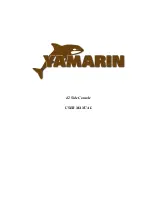
1-3
Safety
Section 1
Exhaust Emissions
All internal combustion engines produce carbon mon-
oxide when they are running. While carbon monoxide
is broadcast with the engine exhaust gases, it is itself
a colorless and odorless gas. It is extremely toxic.
Varying ambient conditions can allow carbon monox-
ide to mix freely with air or cause it to settle and collect
in confined areas in or around your boat. Always be
aware of operating conditions that might allow carbon
monoxide to collect in confined spaces on your boat.
Remember these important precautions:
• Avoid running your outboard engines or portable
fire pump in confined areas such as boat houses
• Be aware of engine exhaust from adjacent boats
when you are moored
• Be aware of wind direction and strength when
operating your boat at slow speeds
• Adjust hatches, doors, windows, and canvas to
increase air movement in occupied spaces when
your outboard engines or portable fire pump are
running
For more information about the dangers of carbon
monoxide, read the booklet
What You Can’t See
that
is in your owner’s bag.
!
DANGER
Prolonged exposure to carbon monoxide can
cause serious injury or death. Always insure
that confined spaces in your boat have an
adequate supply of fresh air.
Summary of Contents for Boston Whaler 21 Guardian Series
Page 18: ...1 10 Section 1 Safety Deck Occupancy Chart...
Page 20: ...1 12 Section 1 Safety Warning Label Chart 1 2 3 4 5 6 7 8 9 6 0 A B D G C E F...
Page 22: ...1 14 Operator Notes...
Page 52: ...2 30 Operator Notes...
Page 56: ...3 4 Section 3 Fuel Systems Fuel System Diagram 1 2 5 3 6 7 9 4 8 0 A B C...
Page 68: ...4 2 Section 4 Boat Systems Control Console Layout 1 2 3 4 5 7 6 8 9 0 B A C E G I D F H J K...
Page 97: ...5 7 Operator Notes...
Page 126: ...6 20 Operator Notes...












































